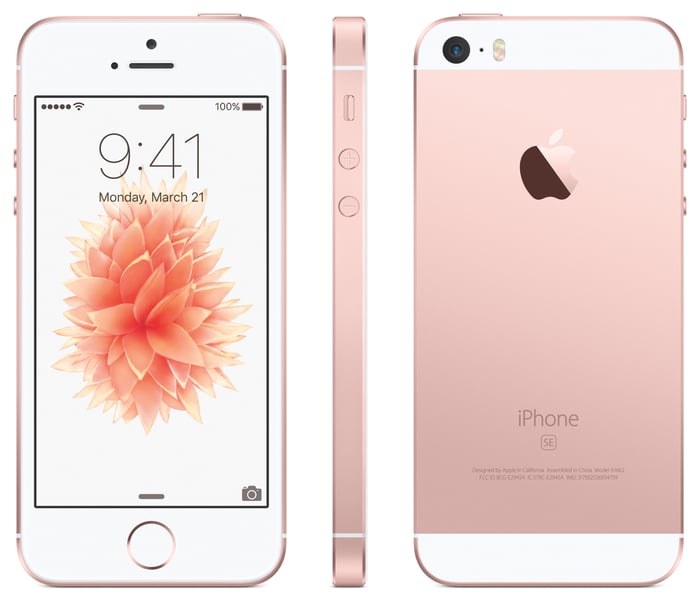Apple's (AAPL 1.97%) iPhone business is easily the most successful smartphone franchise in the world as it captures the substantial majority of the profits to be had in the smartphone market.
According to Counterpoint Research (via MarketWatch), Apple managed to capture 60% of the industry's profits during the third quarter of the year. This eclipsed the profit share of its nearest competitor, Samsung Electronics (NASDAQOTH: SSNLF), which reportedly grabbed a 26% share.

Image source: Apple.
Though Apple leads the industry in terms of profit share, its share of worldwide smartphone shipments is quite small -- 11.9% during the third quarter, per Gartner. Apple's disproportionately high-profit share relative to its unit share is due largely to its dominant share position within the market for high-priced smartphones. Apple's iPhone product lineup starts at $349 and goes to $1,149, with the bulk of its sales being higher-priced models.
Other smartphone manufacturers sell a lot of low priced phones that, individually, don't generate a lot of profit. It's fair to say, then, that while Apple's share of the overall smartphone market isn't that meaningful a figure, its share of the premium smartphone market matters a great deal.
Maintaining premium phone share
Apple has always faced significant competitive intensity in the premium portion of the smartphone market, and I think that this intensity is set to increase. Apple will continue to see competitive pressure from traditional rivals, like Samsung, but new threats seem to be emerging.
China's Huawei is putting out high-end Android-based handsets that seem to be positively received in China. Moreover, AT&T, a major U.S. smartphone carrier, is expected to begin selling Huawei's flagship Mate 10 smartphone next year, giving U.S.-based smartphone customers yet another high-end smartphone option to choose from.
On top of that, Alphabet's(GOOG 3.10%) (GOOGL 3.11%) Google, which develops the popular Android operating system, continues to invest in its Pixel line of smartphones. Given Google's brand strength and some of the unique features of its phones (e.g. the Pixel 2's camera edges out the iPhone X's in DXOMark -- a battery of tests designed to measure a camera's performance), this series of phones could erode Apple's share over time.
Apple isn't sitting still, though. This year it introduced the innovative iPhone X (though the lower-priced iPhone 8 and iPhone 8 Plus were largely seen as incremental updates to last year's iPhones), and for next year it seems to be preparing a broader portfolio of iPhones (including a lower-cost variant of the iPhone X as well as a larger-screen iPhone X).
Over the next year or two, Apple's iPhone business is probably poised to gain premium smartphone share rather than maintain what it has or even lose it. That's due to the introduction of the iPhone X this year and an even more compelling lineup in the following year. Beyond that, though, things could get tougher.
Closing gaps, opening new ones
Longer term -- that is, beyond the current product cycle and the subsequent one -- Apple is going to need to take steps to ensure feature/technology leadership over the competition. Apple currently leads the way with its 3D facial recognition technologies but lacks in camera performance, where it is merely at parity with or behind the competition.
The fact that the Google Pixel 2 edges the iPhone X out in DXOMark, for example, seems to indicate that Apple needs to increase, perhaps substantially, its investments in camera technology to try to achieve a leadership position in such an important part of the smartphone user experience.

Image source: Apple.
Apple also needs to be more aggressive about form factor innovation. Though there are good reasons why Apple recycled the same basic form factor for four generations of iPhones, Apple would be putting itself at a substantial competitive disadvantage if it were to use the same basic iPhone X form factor for four generations. It's worth pointing out that a big long-term risk to relying on form factor to sell phones is that eventually all phones are destined to converge on the same basic form factor.
Apple also needs to be more aggressive about display innovation. Apple seems to deliver substantial quality improvements to its iPhone displays every two years, but many of its competitors deliver improvements each year. To keep pace, Apple needs to deliver annual improvements.
Beyond innovations along the usual technology vectors, Apple has to continually introduce new technologies that fundamentally change the user experience, such as the 3D sensing capabilities on the iPhone X. Any innovation Apple introduces will almost certainly be copied by a competitor within a year, or possibly less, so Apple needs to keep them coming at a rapid clip.
The situation isn't impossible for Apple, but it'll be far from easy over the long term.





